Introduction
Mental illness is described as the behavior exhibited by individuals who are not in their normal states of mind (Goldberg 204). As a result, there is need to restore the normal state of mind. Medical practitioners have resorted to the use of drugs in treating symptoms associated with mental disorders. The drugs are aimed at altering the patient’s state of mind through the modification of physiological and chemical processes executed by the individual’s central nervous system. The drugs are commonly referred to as ‘psychotherapeutic drugs’. The drugs achieve their intended purpose by interfering with nerve impulses. When used appropriately, psychotherapeutic drugs assist individuals suffering from mental disorders to achieve the right mental state under controlled conditions. Psychotherapeutic drugs, however, pose serious health risks to an individual when abused . In severe cases , they may permanently alter brain processes. In addition, addiction arises from abuse of the drugs.
The paper aims at fully understanding the term ‘mental illness.’ In addition, the relationship between mental illness and medicine is discussed. The issue of increased susceptibility to mental illness among certain groups is also tackled. Finally, types of mental disorders are discussed towards the end of the paper.
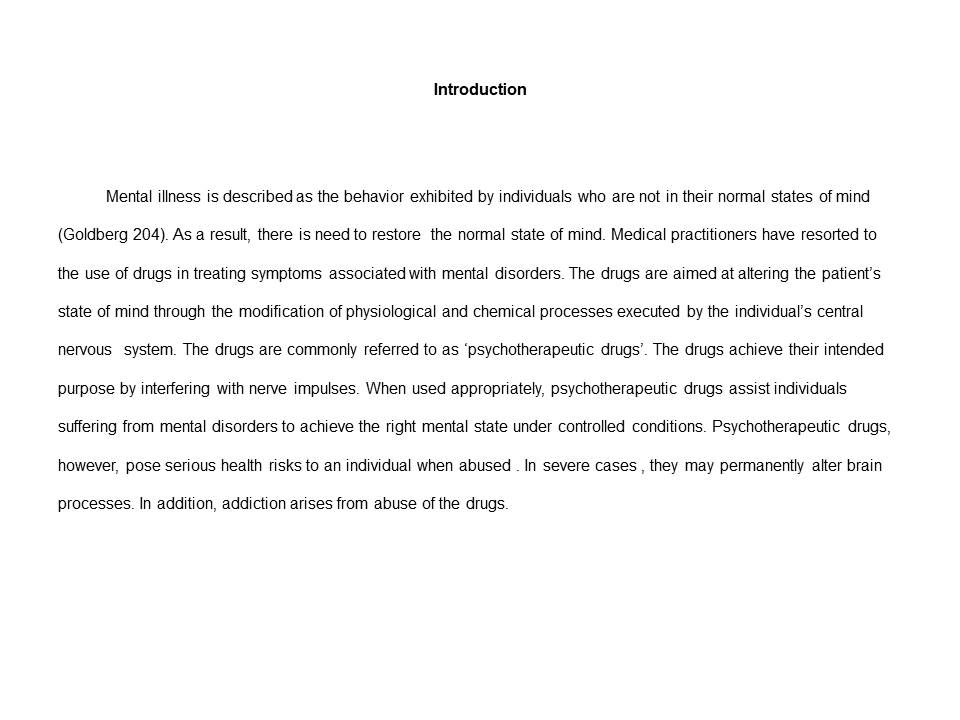

Mental Illness
Mental illness is the term used to refer to the abnormal state of mind characterized by psychological patterns and usually associated with distress (Kinderman and Lobban 308). Benjamin Rush, an American physician, simply describes the condition as an illness of the brain. The condition is brought about by a disease affecting the brain. Chemical imbalances in the brain is another major cause of the condition. Psychologists describe the abnormal state of mind as inappropriate thinking and conduct in an individual. However, confusion arises when determining the right definition of the term ‘inappropriate’.
Despite the presence of many definitions attempting to describe the condition, it is clear that mental illness is brought about by malfunctions of parts of the brain or the entire nervous system. The nervous system is a mass of neurons connected to each other (Pilgrim and Rogers 78). Defects in a single neuron will in turn affect the entire nervous system. Psychotherapy and psychotherapeutic drugs are the only known forms of treatment for the condition. Psychotherapeutic drugs are aimed at reducing the effects of the condition, enabling the individual to lead a normal life as long as the prescribed medication is adhered to. Sedatives and tranquilizes are the most commonly used drugs when dealing with psychiatric cases.
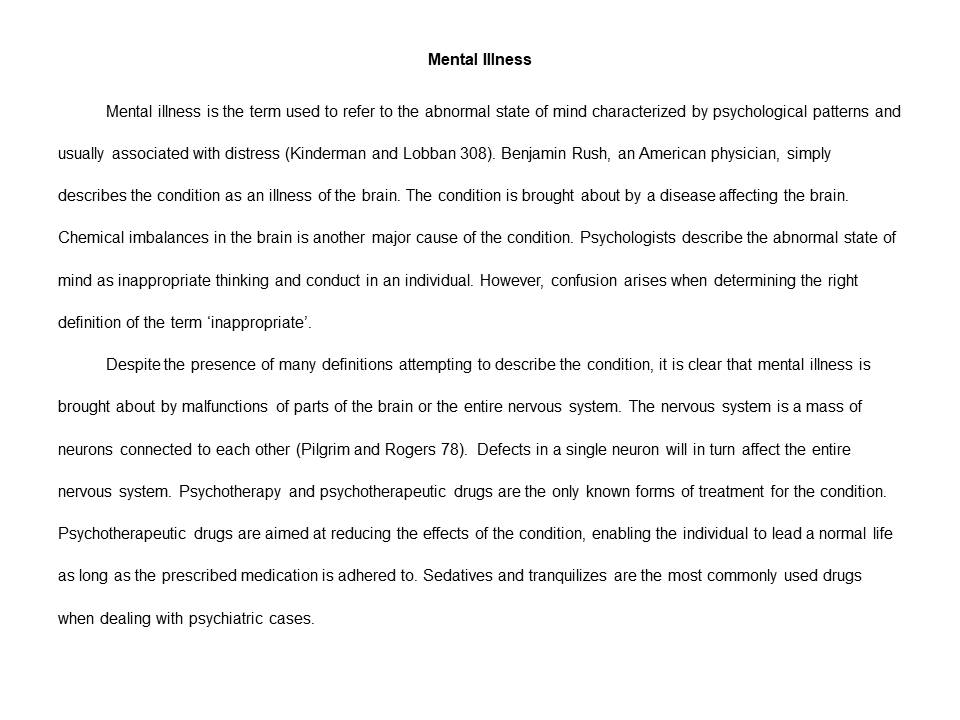
Mental Illness and Medicine
Medical practitioners are charged with the responsibility of diagnosing cases of mental illnesses among patients. Mental illnesses have two major causes identified by medical practitioners. The causes are chemical imbalances in the brain and a disease affecting the brain or the nervous system (Goldberg 204).
A pathogen transmits the disorder when the mental illness is caused by a disease affecting the brain. The concept is commonly referred to as the medical model. The treatment or prevention of the disease associated with mental illness will translate to the treatment or prevention of the mental illness. In such a case, mental illness is described as a disease with symptoms. It is a disease with a cure (Kinderman and Lobban 308). Psychotherapeutic drugs aimed at treating the mental illness are administered to the patient to facilitate recovery. The psychotherapeutic drugs target specific symptoms exhibited by a mentally ill patient . They aim at suppressing the effects of the condition. The drugs achieve this by initiating or inhibiting brain processes.
Critics feel that administration of drugs to treat behavior is inappropriate. The argument is based on the opinion that mental illness is just an inappropriate state of mind and is not necessarily caused by a disease. People have different ways of dealing with pressure and stress, and their reactions should not be construed as a mental illness (Pilgrim and Rogers 78). Medical practitioners face difficulties distinguishing between appropriate and inappropriate behavior.
Thomas, a critic of the medical model, is of the view that mental illness is just a myth. He further argues that drugs should not be administered to those identified as mentally ill since drugs are intended to treat specific ailments, not behavior. As a result, psychologists have a hard time diagnosing cases of mental illness in a population.
Difficulties associated with the diagnosis of mental illnesses pose a major challenge to the determination of the right drug to administer to patients. Psychotherapeutic drugs administered in cases of mental illnesses are aimed at treating the symptoms exhibited. Such a mode of treatment is aimed at suppressing the effects of the mental illness on an individual. Critics say that little is achieved through the administration of the drugs since treatment is only concerned with the symptoms, rather than the root cause of the mental illness.
Treatment of symptoms in a mental patient translates to the suppression of the effects of the illness. As such, the behavior of the patient is controlled as long as they adhere to the prescription specified by the medical practitioner. Therefore, psychotherapeutic drugs are aimed at treating the symptoms, rather than curing the mental disorder. As a result, they must be administered from time to time.
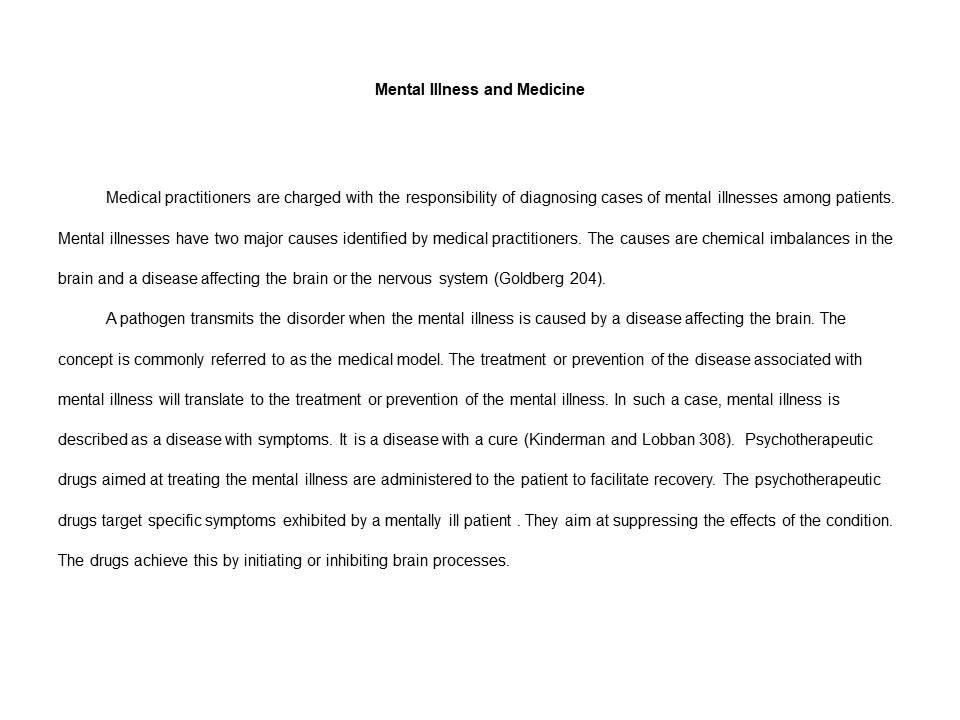
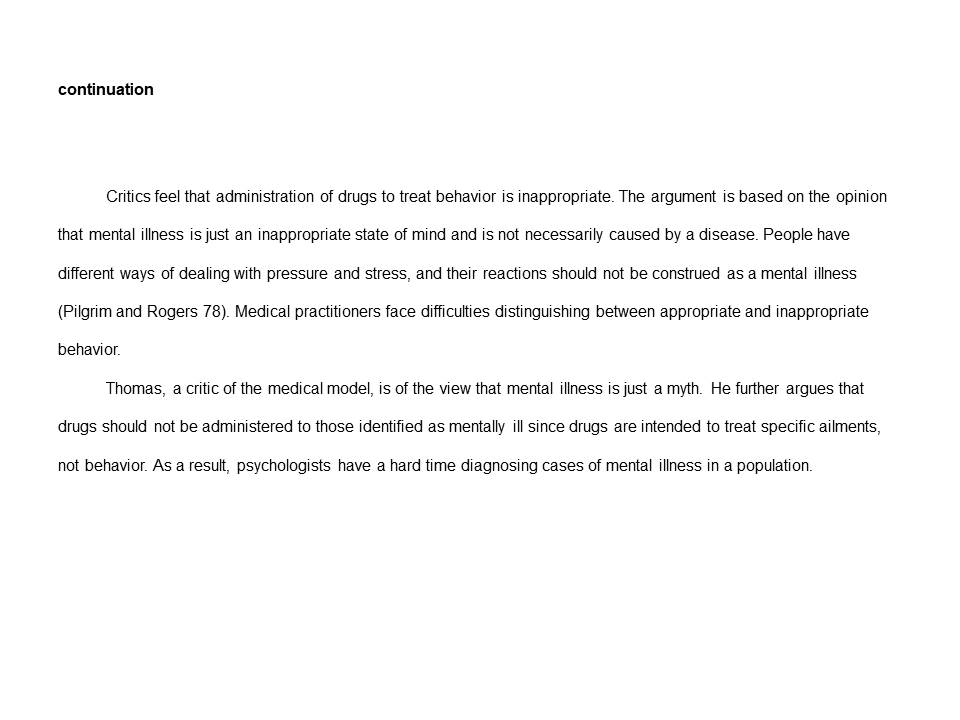
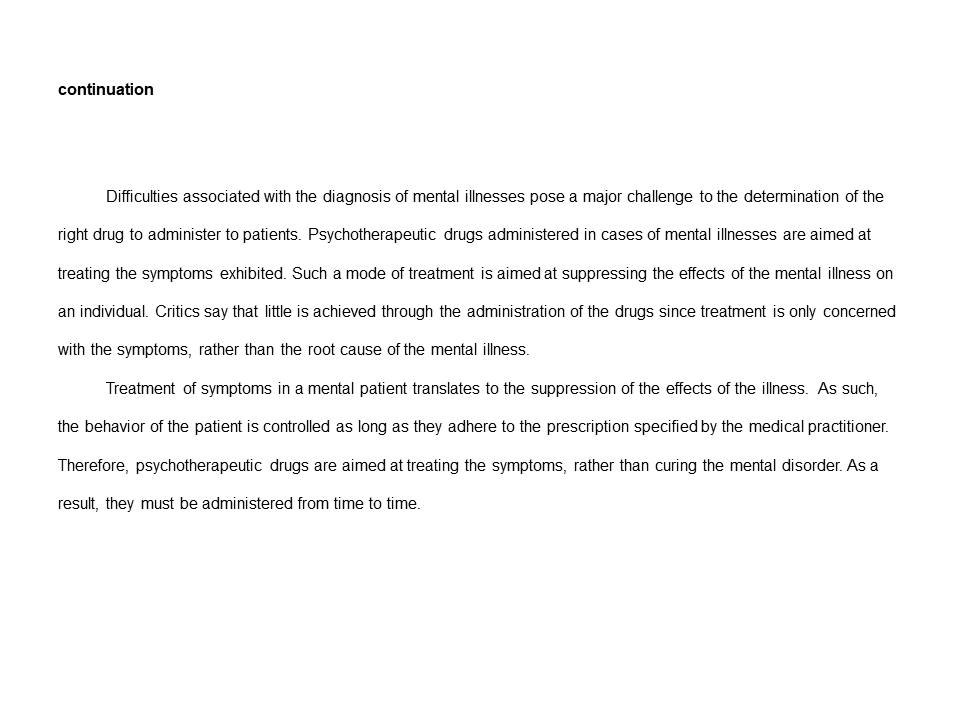
Mental Illness and Special Population
Statistics show that all groups of people are susceptible to mental illnesses. Cases of mental illnesses are reported among people from all walks of life. The condition is, however, more common among adolescents between the ages of 16 and 17 years compared to other groups of people (Goldberg 204). Close to 12 percent of individuals in this age group exhibit instances of depression. In addition, research has shown that more than half of adults suffering from mental illnesses started exhibiting the symptoms when they were still young.
Researchers and medical practitioners have attributed the rising cases of mental illnesses among adolescents to unfavorable family backgrounds and relations. Build-up of stress as a result of these conditions leads to depression. Depression alters the behavior of a person. Psychotherapeutic drugs are administered to these individuals to suppress the diagnosed symptoms. Out of all the drugs available, sedatives are the most appropriate in this case since they have a calming effect on users (Kinderman and Lobban 308).
Postpartum mothers are more vulnerable to mental illnesses compared to other women (Goldberg 205). The group is reported to experience episodes of depression in the period just after birth. The symptoms can extend up to twelve months after birth. Research has shown that young women have a high risk of experiencing postpartum stress compared to older mothers. The severity of postpartum stress is aggravated by partner-related stress and relationship wrangles, such as cases of physical abuse by partners. In addition, the elderly people in the society are more susceptible to mental illnesses compared to young adults (Goldberg 205). The group is made up of people aged fifty years and above.
The three special groups account for the largest number of mentally ill persons in the society. Cases of suicide among individuals in these groups is on the rise. Provision of psychotherapeutic drugs to the three groups will go a long way in winning the fight against mental illnesses. The drugs should be made available to these groups.
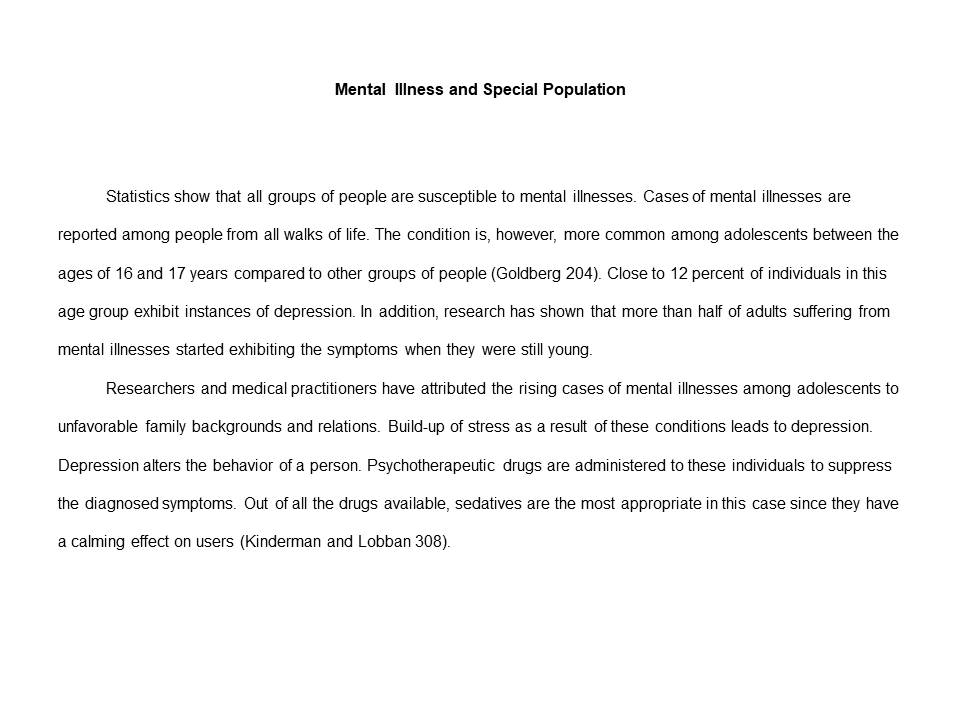
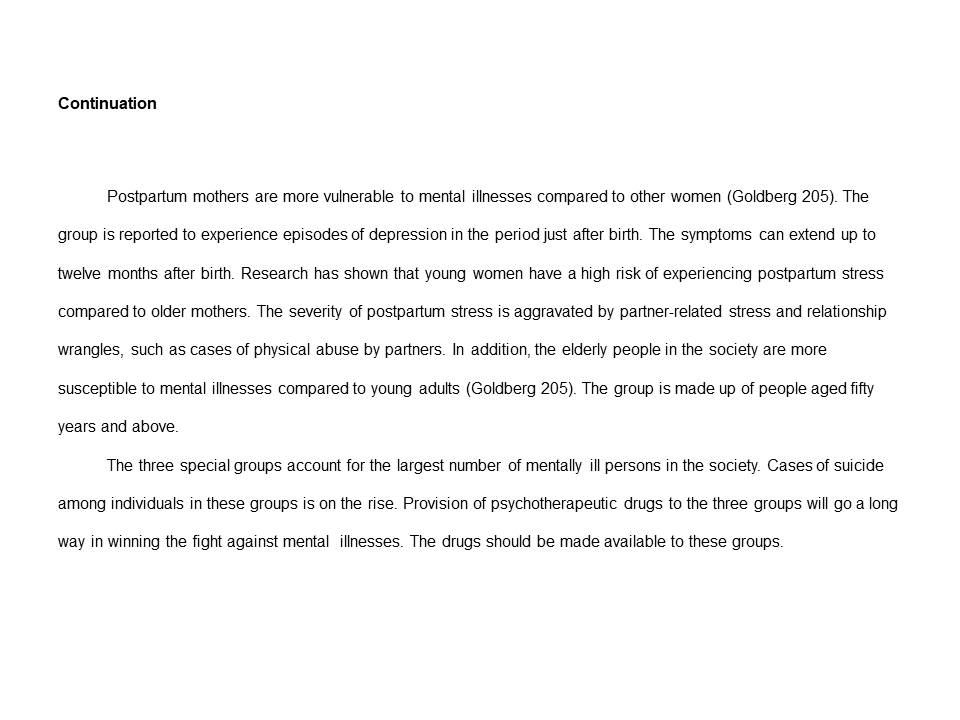
Types of Mental Disorders
In some cases, mental disorders are associated with emotional problems. Victims are not in a position to distinguish between mere imagination and reality (Goldberg 204). The patients experience unrealistic fears and anxieties. Mental disorders include anxiety and psychosis.
Psychosis occurs when the individual is not in a position to differentiate between reality and mere speculation. The disorder is divided into two categories; organic and schizophrenia. Organic psychosis is brought about by physical factors, such as drug and substance abuse, as well as neurological diseases. Psychotherapeutic drugs applied in such cases are aimed at treating the effects of the physical causes of the condition. On the other hand, schizophrenia affects an individual’s personality. It may lead to multiple personality disorder among individuals. Psychotherapeutic drugs are applied to alter behavior in cases of schizophrenia. Sedatives, for instance, are used to induce calmness. As a result, they reduce cases of violent behavior among mentally ill patients (Pilgrim and Rogers 78).
Patients suffering from anxiety experience abnormal fears. Their life is full of worries, leading to distress and restlessness. Psychotherapeutic drugs used in such cases are mainly sedatives, which are aimed at calming the patient. When used in low doses, sedatives reduce anxiety levels among patients, calming them down (Goldberg 204). High doses sedate the patient. The high doses may be used to induce sleep in a patient when the need arises.
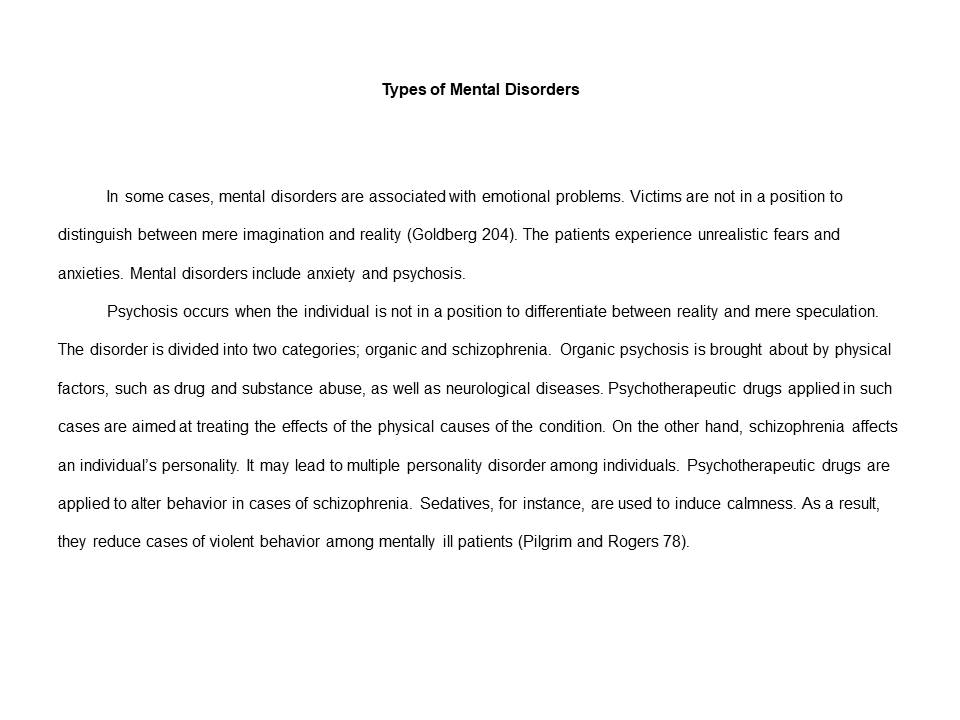
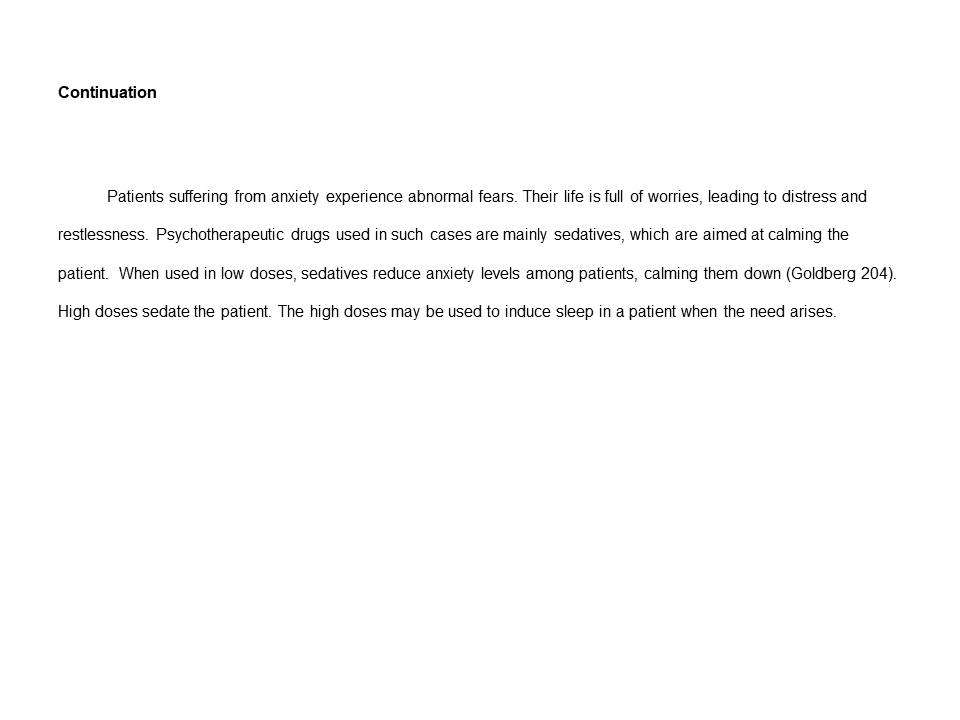
Conclusion
Psychotherapeutic drugs are used to help individuals suffering from mental illnesses attain the right mental state. Sedatives and tranquilizers are the two major types of drugs used in the treatment of psychiatric conditions. Other types of drugs used in psychotherapy include, among others, antidepressants, pain killers, depressants, and stimulants. However, the patient should strictly adhere to the prescribed dosage to attain the desired effects without putting their health at risk (Pilgrim and Rogers 78).
Psychotherapeutic drugs pose serious health risks to users when abused. They may permanently alter brain processes (Goldberg 206). In addition, abuse of these drugs may lead to addiction. Individuals using sedatives and tranquilizers have reported cases of addiction, where they become habitual users of the drugs.
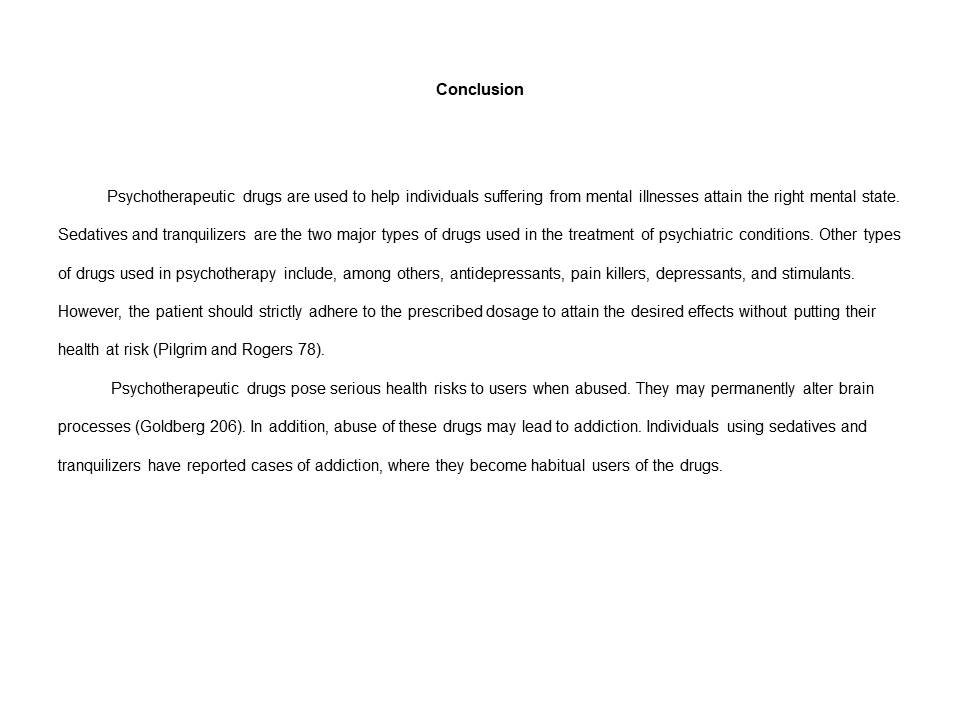
Works Cited
Goldberg, Raymond. Drugs Across the Spectrum, Belmont: Wadsworth, 2010. Print.
Kinderman, Peter and Fiona Lobban. “Evolving Formulations: Sharing Complex Information With Clients.” Behavioral and Cognitive Psychotherapy 28.3 (2005) 307–310. Print.
Pilgrim, David, and A. Rogers. A Sociology of Mental Health and Illness, New York: Open University Press, 2005. Print.